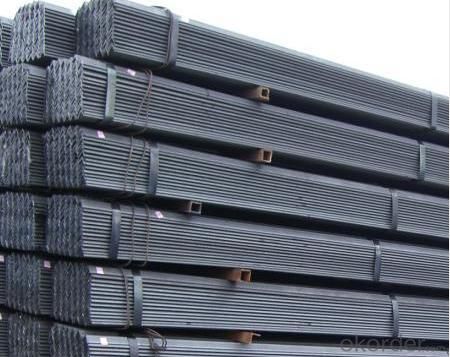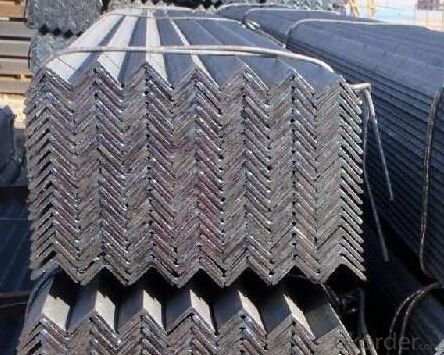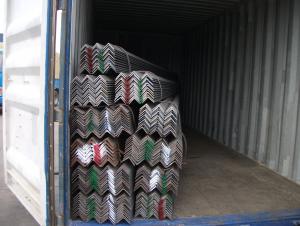JIS SS400 High Quality Angle Steel
- Loading Port:
- China Main Port
- Payment Terms:
- TT or LC
- Min Order Qty:
- -
- Supply Capability:
- -
OKorder Service Pledge
OKorder Financial Service
You Might Also Like
Product Description:
OKorder is offering JIS SS400 High Quality Angle Steel at great prices with worldwide shipping. Our supplier is a world-class manufacturer of steel, with our products utilized the world over. OKorder annually supplies products to European, North American and Asian markets. We provide quotations within 24 hours of receiving an inquiry and guarantee competitive prices.
Product Applications:
JIS SS400 High Quality Angle Steel are ideal for structural applications and are widely used in the construction of buildings and bridges, and the manufacturing, petrochemical, and transportation industries.
Product Advantages:
OKorder's JIS SS400 High Quality Angle Steel are durable, strong, and resist corrosion.
Main Product Features:
· Premium quality
· Prompt delivery & seaworthy packing (30 days after receiving deposit)
· Corrosion resistance
· Can be recycled and reused
· Mill test certification
· Professional Service
· Competitive pricing
Specifications of JIS SS400 Angle Steel
1.Standards:GB,ASTM,BS,AISI,DIN,JIS
2.Invoicing on theoretical weight or actual weight as customer request
3.Material: JIS G3192,SS400;SS540.
4. Payment terms:
1).100% irrevocable L/C at sight.
2).30% T/T prepaid and the balance against the copy of B/L.
3).30% T/T prepaid and the balance against L/C
5.Sizes:
EQUAL ANGLES SIZES |
| ||
a(mm) | a1(mm) | thickness(mm) | length |
25 | 25 | 2.5---3.0 | 6M/12M |
30 | 30 | 2.5---4.0 | 6M/12M |
38 | 38 | 2.5 | 6M/12M |
38 | 38 | 3.0---5.0 | 6M/12M |
40 | 40 | 3.0---6.0 | 6M/12M |
50 | 50 | 3 | 6M/12M |
50 | 50 | 3.7---6.0 | 6M/9M/12M |
60 | 60 | 5.0---6.0 | 6M/9M/12M |
63 | 63 | 6.0---8.0 | 6M/9M/12M |
65 | 65 | 5.0---8.0 | 6M/9M/12M |
70 | 70 | 6.0---7.0 | 6M/9M/12M |
75 | 75 | 5.0---10.0 | 6M/9M/12M |
80 | 80 | 6.0---10.0 | 6M/9M/12M |
90 | 90 | 6.0---10.0 | 6M/9M/12M |
100 | 100 | 6.0---12.0 | 6M/9M/12M |
120 | 120 | 8.0-12.0 | 6M/9M/12M |
125 | 125 | 8.0---12.0 | 6M/9M/12M |
130 | 130 | 9.0-12.0 | 6M/9M/12M |
140 | 140 | 10.0-16.0 | 6M/9M/12M |
150 | 150 | 10---15 | 6M/9M/12M |
160 | 160 | 10---16 | 6M/9M/12M |
180 | 180 | 12---18 | 6M/9M/12M |
200 | 200 | 14---20 | 6M/9M/12M |
5. Material Specifications:
Grade | Yield Strength,N/mm² | Extension Strength N/mm² | |||
Thickness of Steel,mm | |||||
≦16 | >16-≦40 | >40-≦100 | >100 | ||
SS330 | ≧205 | ≧195 | ≧175 | ≧165 | 330-430 |
SS400 | ≧245 | ≧235 | ≧215 | ≧205 | 400-510 |
SS490 | ≧285 | ≧275 | ≧255 | ≧245 | 490-610 |
SS540 | ≧400 | ≧390 | - | - | ≧540 |
Usage & Applications JIS SS400 Angle Steel
Trusses;
Transmission towers;
Telecommunication towers;
Bracing for general structures;
Stiffeners in structural use.
Packaging & Delivery of JIS SS400 Angle Steel
1. Transportation: the goods are delivered by truck from mill to loading port, the maximum quantity can be loaded is around 40MTs by each truck. If the order quantity cannot reach the full truck loaded, the transportation cost per ton will be little higher than full load.
2. With bundles and load in 20 feet/40 feet container, or by bulk cargo, also we could do as customer's request.
3. Marks:
Color mark: There will be color marking on both end of the bundle for the cargo delivered by bulk vessel. That makes it easily to distinguish at the destination port.
Tag mark: There will be tag mark tied up on the bundles. The information usually including supplier logo and name, product name, made in China, shipping marks and other information request by the customer.
If loading by container the marking is not needed, but we will prepare it as customer request.
Production flow of JIS SS400 Angle Steel
Material prepare (billet) —heat up—rough rolling—precision rolling—cooling—packing—storage and transportation
FAQ:
Q1: Why buy Materials & Equipment from OKorder.com?
A1: All products offered byOKorder.com are carefully selected from China's most reliable manufacturing enterprises. Through its ISO certifications, OKorder.com adheres to the highest standards and a commitment to supply chain safety and customer satisfaction.
Q2: How do we guarantee the quality of our products?
A2: We have established an advanced quality management system which conducts strict quality tests at every step, from raw materials to the final product. At the same time, we provide extensive follow-up service assurances as required.
Q3: How soon can we receive the product after purchase?
A3: Within three days of placing an order, we will begin production. The specific shipping date is dependent upon international and government factors, but is typically 7 to 10 workdays.
Images:


- Q:How do you calculate the compression capacity of a steel angle?
- To calculate the compression capacity of a steel angle, you need to consider the cross-sectional area of the angle and the material's yield strength. The compression capacity can be determined by multiplying the cross-sectional area of the angle by the yield strength of the steel.
- Q:Are steel angles suitable for manufacturing equipment enclosures?
- Indeed, steel angles prove to be an appropriate choice for the fabrication of equipment enclosures. Given their robustness and enduring nature, steel angles are widely utilized in both construction and manufacturing sectors. They furnish a solid framework for enclosing equipment and can be effortlessly joined through welding or bolting to ensure a secure enclosure. Moreover, steel angles can be tailored to suit precise dimensions and can be effortlessly adjusted or extended if necessary. In summary, steel angles present a dependable and economically viable solution for the production of equipment enclosures.
- Q:Can steel angles be used as supports for HVAC systems or ductwork?
- Yes, steel angles can be used as supports for HVAC systems or ductwork. Steel angles are commonly used in construction and engineering projects due to their strength and durability. They can provide a stable and secure support structure for HVAC systems or ductwork, ensuring that they are properly installed and can withstand the weight and vibrations associated with their operation. Steel angles can be easily fabricated and installed, making them a cost-effective and efficient solution for supporting HVAC systems or ductwork.
- Q:What is the cost of a steel angle?
- The cost of a steel angle can vary depending on several factors such as the size, grade, thickness, and the supplier or manufacturer. Generally, steel angles are priced per length or per weight. It is important to consider the market conditions, location, and the specific requirements of the steel angle needed when determining the cost. It is recommended to contact local suppliers or manufacturers for accurate and up-to-date pricing information.
- Q:How do you prevent steel angles from sagging?
- Steel angles can be prevented from sagging by providing adequate support and reinforcement. This can be achieved by using additional structural steel elements such as beams or columns to provide continuous support along the length of the angle. Additionally, appropriate fastening techniques, such as welding or bolting, should be used to ensure a secure connection between the angle and the supporting structure. Regular inspection and maintenance are also essential to detect any signs of sagging and take necessary corrective measures in a timely manner.
- Q:Are steel angles suitable for earthquake-prone areas?
- Steel angles are commonly used in construction, particularly in earthquake-prone areas, due to their excellent structural properties. The L-shaped design of steel angles provides significant stability and strength, making them suitable for withstanding seismic forces. Steel angles are known for their high tensile strength and ability to resist bending and twisting, which is crucial during an earthquake. Additionally, steel is a ductile material, meaning it can undergo significant deformation without undergoing failure, thus absorbing some of the energy generated by seismic activity. This flexibility helps to prevent catastrophic structural collapse during an earthquake. Furthermore, steel angles can be easily bolted or welded together, allowing for efficient and cost-effective construction. However, it is important to note that the design and construction of structures in earthquake-prone areas should be done in accordance with local building codes and regulations to ensure maximum safety.
- Q:How do you calculate the bending moment of a loaded steel angle?
- To calculate the bending moment of a loaded steel angle, you need to consider the applied load, the moment arm, and the cross-sectional properties of the angle. First, determine the applied load acting on the steel angle. This could be a point load or a distributed load, depending on the specific situation. Next, locate the point of application of the load and determine the moment arm. The moment arm is the perpendicular distance between the point of application of the load and the axis of rotation. Once you have the applied load and the moment arm, you can calculate the bending moment using the formula: Bending Moment = Applied Load x Moment Arm Finally, you need to consider the cross-sectional properties of the steel angle. These include the area moment of inertia (I) and the section modulus (Z). The area moment of inertia measures the resistance to bending and depends on the shape and dimensions of the angle. The section modulus represents the strength of the section and is calculated as the ratio of the area moment of inertia to the distance from the centroid to the extreme fiber. By using the appropriate equations and considering the cross-sectional properties, you can determine the bending moment capacity of the loaded steel angle and assess its structural integrity under the given load conditions.
- Q:Can steel angles be used in mezzanine or raised platform construction?
- Yes, steel angles can be used in mezzanine or raised platform construction. Steel angles provide structural support and stability, making them a suitable choice for such applications.
- Q:Can steel angles be cut to size?
- Yes, steel angles can be cut to size using various cutting tools and techniques such as sawing, shearing, or plasma cutting.
- Q:Can steel angles be used in railway infrastructure?
- Yes, steel angles can be used in railway infrastructure. They are commonly used in the construction of railway tracks, bridges, and other structures due to their high strength, durability, and ability to withstand heavy loads. Steel angles provide structural support and stability, making them an essential component in railway infrastructure projects.
1. Manufacturer Overview |
|
|---|---|
| Location | |
| Year Established | |
| Annual Output Value | |
| Main Markets | |
| Company Certifications | |
2. Manufacturer Certificates |
|
|---|---|
| a) Certification Name | |
| Range | |
| Reference | |
| Validity Period | |
3. Manufacturer Capability |
|
|---|---|
| a)Trade Capacity | |
| Nearest Port | |
| Export Percentage | |
| No.of Employees in Trade Department | |
| Language Spoken: | |
| b)Factory Information | |
| Factory Size: | |
| No. of Production Lines | |
| Contract Manufacturing | |
| Product Price Range | |
Send your message to us
JIS SS400 High Quality Angle Steel
- Loading Port:
- China Main Port
- Payment Terms:
- TT or LC
- Min Order Qty:
- -
- Supply Capability:
- -
OKorder Service Pledge
OKorder Financial Service
Similar products
New products
Hot products
Related keywords





























